bonnet FIAT FULLBACK 2017 Owner handbook (in English)
[x] Cancel search | Manufacturer: FIAT, Model Year: 2017, Model line: FULLBACK, Model: FIAT FULLBACK 2017Pages: 312, PDF Size: 12.31 MB
Page 76 of 312
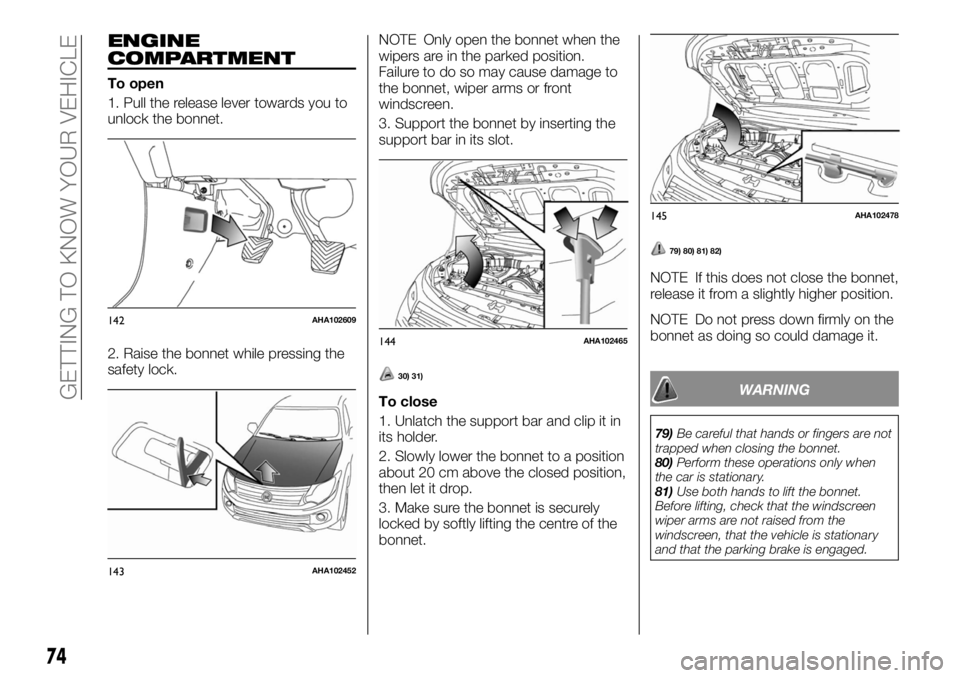
ENGINE
COMPARTMENT
To open
1. Pull the release lever towards you to
unlock the bonnet.
2. Raise the bonnet while pressing the
safety lock.NOTE Only open the bonnet when the
wipers are in the parked position.
Failure to do so may cause damage to
the bonnet, wiper arms or front
windscreen.
3. Support the bonnet by inserting the
support bar in its slot.
30) 31)
To close
1. Unlatch the support bar and clip it in
its holder.
2. Slowly lower the bonnet to a position
about 20 cm above the closed position,
then let it drop.
3. Make sure the bonnet is securely
locked by softly lifting the centre of the
bonnet.
79) 80) 81) 82)
NOTE If this does not close the bonnet,
release it from a slightly higher position.
NOTE Do not press down firmly on the
bonnet as doing so could damage it.
WARNING
79)Be careful that hands or fingers are not
trapped when closing the bonnet.
80)Perform these operations only when
the car is stationary.
81)Use both hands to lift the bonnet.
Before lifting, check that the windscreen
wiper arms are not raised from the
windscreen, that the vehicle is stationary
and that the parking brake is engaged.
142AHA102609
143AHA102452
144AHA102465
145AHA102478
74
GETTING TO KNOW YOUR VEHICLE
Page 77 of 312
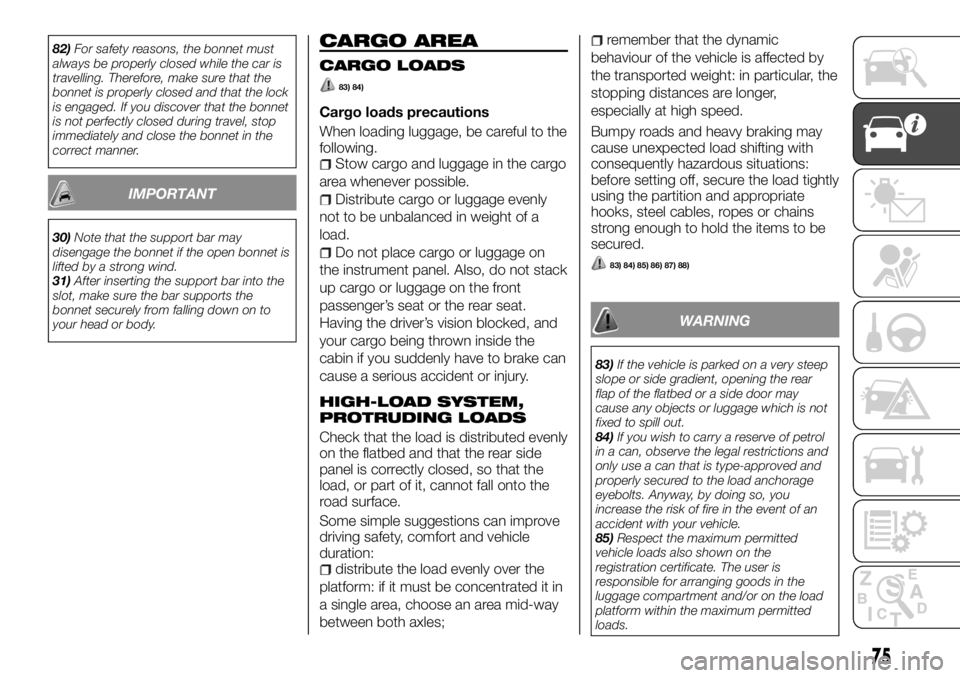
82)For safety reasons, the bonnet must
always be properly closed while the car is
travelling. Therefore, make sure that the
bonnet is properly closed and that the lock
is engaged. If you discover that the bonnet
is not perfectly closed during travel, stop
immediately and close the bonnet in the
correct manner.
IMPORTANT
30)Note that the support bar may
disengage the bonnet if the open bonnet is
lifted by a strong wind.
31)After inserting the support bar into the
slot, make sure the bar supports the
bonnet securely from falling down on to
your head or body.
CARGO AREA
CARGO LOADS
83) 84)
Cargo loads precautions
When loading luggage, be careful to the
following.
Stow cargo and luggage in the cargo
area whenever possible.
Distribute cargo or luggage evenly
not to be unbalanced in weight of a
load.
Do not place cargo or luggage on
the instrument panel. Also, do not stack
up cargo or luggage on the front
passenger’s seat or the rear seat.
Having the driver’s vision blocked, and
your cargo being thrown inside the
cabin if you suddenly have to brake can
cause a serious accident or injury.
HIGH-LOAD SYSTEM,
PROTRUDING LOADS
Check that the load is distributed evenly
on the flatbed and that the rear side
panel is correctly closed, so that the
load, or part of it, cannot fall onto the
road surface.
Some simple suggestions can improve
driving safety, comfort and vehicle
duration:
distribute the load evenly over the
platform: if it must be concentrated it in
a single area, choose an area mid-way
between both axles;
remember that the dynamic
behaviour of the vehicle is affected by
the transported weight: in particular, the
stopping distances are longer,
especially at high speed.
Bumpy roads and heavy braking may
cause unexpected load shifting with
consequently hazardous situations:
before setting off, secure the load tightly
using the partition and appropriate
hooks, steel cables, ropes or chains
strong enough to hold the items to be
secured.
83) 84) 85) 86) 87) 88)
WARNING
83)If the vehicle is parked on a very steep
slope or side gradient, opening the rear
flap of the flatbed or a side door may
cause any objects or luggage which is not
fixed to spill out.
84)If you wish to carry a reserve of petrol
in a can, observe the legal restrictions and
only use a can that is type-approved and
properly secured to the load anchorage
eyebolts. Anyway, by doing so, you
increase the risk of fire in the event of an
accident with your vehicle.
85)Respect the maximum permitted
vehicle loads also shown on the
registration certificate. The user is
responsible for arranging goods in the
luggage compartment and/or on the load
platform within the maximum permitted
loads.
75
Page 156 of 312
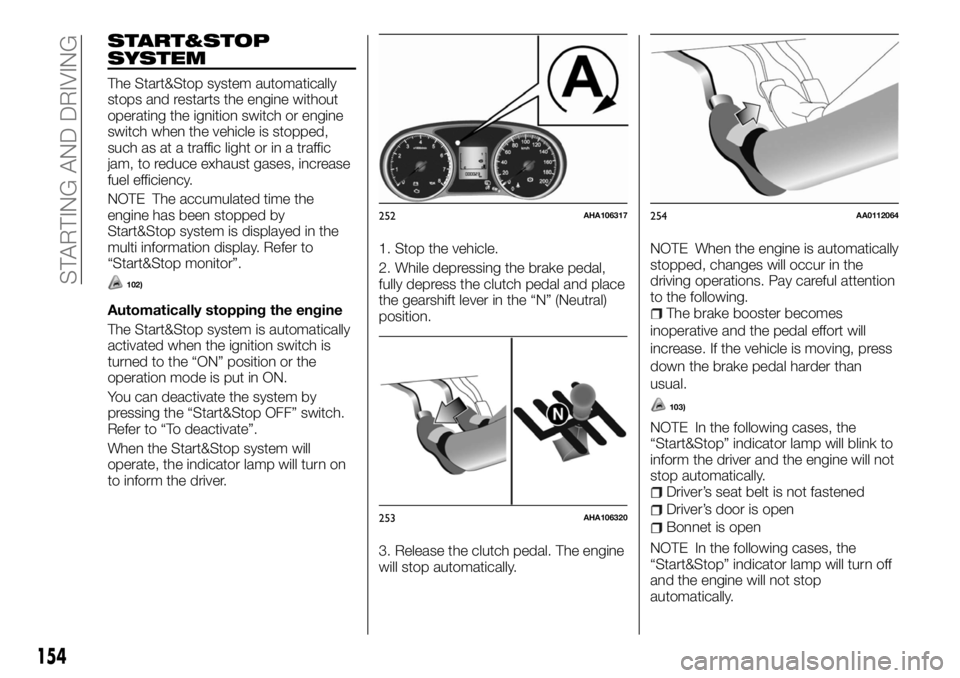
START&STOP
SYSTEM
The Start&Stop system automatically
stops and restarts the engine without
operating the ignition switch or engine
switch when the vehicle is stopped,
such as at a traffic light or in a traffic
jam, to reduce exhaust gases, increase
fuel efficiency.
NOTE The accumulated time the
engine has been stopped by
Start&Stop system is displayed in the
multi information display. Refer to
“Start&Stop monitor”.
102)
Automatically stopping the engine
The Start&Stop system is automatically
activated when the ignition switch is
turned to the “ON” position or the
operation mode is put in ON.
You can deactivate the system by
pressing the “Start&Stop OFF” switch.
Refer to “To deactivate”.
When the Start&Stop system will
operate, the indicator lamp will turn on
to inform the driver.1. Stop the vehicle.
2. While depressing the brake pedal,
fully depress the clutch pedal and place
the gearshift lever in the “N” (Neutral)
position.
3. Release the clutch pedal. The engine
will stop automatically.NOTE When the engine is automatically
stopped, changes will occur in the
driving operations. Pay careful attention
to the following.The brake booster becomes
inoperative and the pedal effort will
increase. If the vehicle is moving, press
down the brake pedal harder than
usual.
103)
NOTE In the following cases, the
“Start&Stop” indicator lamp will blink to
inform the driver and the engine will not
stop automatically.
Driver’s seat belt is not fastened
Driver’s door is open
Bonnet is open
NOTE In the following cases, the
“Start&Stop” indicator lamp will turn off
and the engine will not stop
automatically.
252AHA106317
253AHA106320
254AA0112064
154
STARTING AND DRIVING
Page 158 of 312
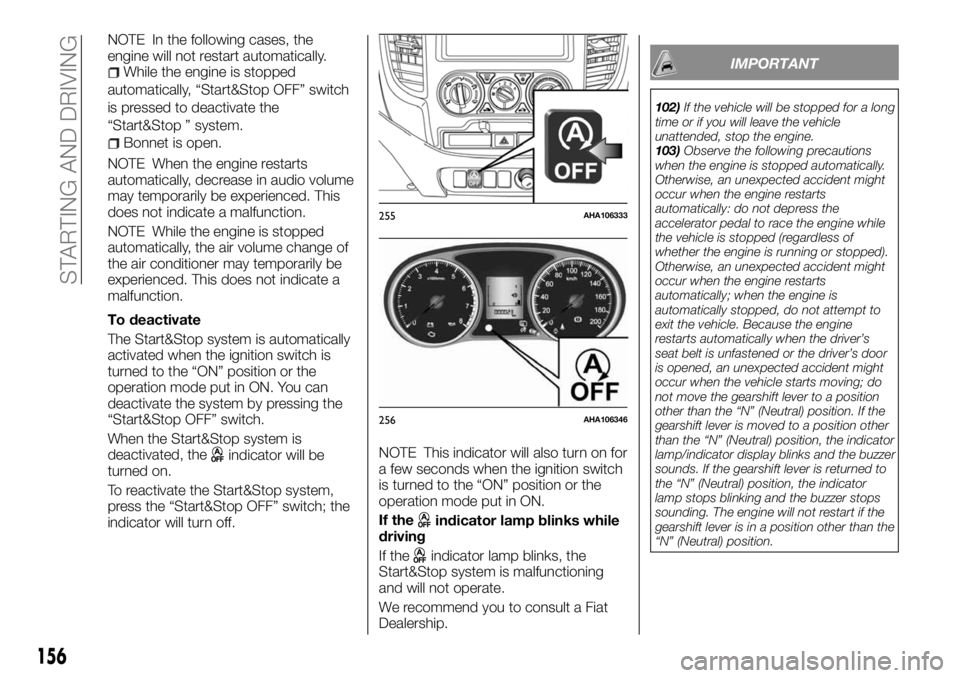
NOTE In the following cases, the
engine will not restart automatically.
While the engine is stopped
automatically, “Start&Stop OFF” switch
is pressed to deactivate the
“Start&Stop ” system.
Bonnet is open.
NOTE When the engine restarts
automatically, decrease in audio volume
may temporarily be experienced. This
does not indicate a malfunction.
NOTE While the engine is stopped
automatically, the air volume change of
the air conditioner may temporarily be
experienced. This does not indicate a
malfunction.
To deactivate
The Start&Stop system is automatically
activated when the ignition switch is
turned to the “ON” position or the
operation mode put in ON. You can
deactivate the system by pressing the
“Start&Stop OFF” switch.
When the Start&Stop system is
deactivated, the
indicator will be
turned on.
To reactivate the Start&Stop system,
press the “Start&Stop OFF” switch; the
indicator will turn off.NOTE This indicator will also turn on for
a few seconds when the ignition switch
is turned to the “ON” position or the
operation mode put in ON.
If the
indicator lamp blinks while
driving
If the
indicator lamp blinks, the
Start&Stop system is malfunctioning
and will not operate.
We recommend you to consult a Fiat
Dealership.
IMPORTANT
102)If the vehicle will be stopped for a long
time or if you will leave the vehicle
unattended, stop the engine.
103)Observe the following precautions
when the engine is stopped automatically.
Otherwise, an unexpected accident might
occur when the engine restarts
automatically: do not depress the
accelerator pedal to race the engine while
the vehicle is stopped (regardless of
whether the engine is running or stopped).
Otherwise, an unexpected accident might
occur when the engine restarts
automatically; when the engine is
automatically stopped, do not attempt to
exit the vehicle. Because the engine
restarts automatically when the driver’s
seat belt is unfastened or the driver’s door
is opened, an unexpected accident might
occur when the vehicle starts moving; do
not move the gearshift lever to a position
other than the “N” (Neutral) position. If the
gearshift lever is moved to a position other
than the “N” (Neutral) position, the indicator
lamp/indicator display blinks and the buzzer
sounds. If the gearshift lever is returned to
the “N” (Neutral) position, the indicator
lamp stops blinking and the buzzer stops
sounding. The engine will not restart if the
gearshift lever is in a position other than the
“N” (Neutral) position.
255AHA106333
256AHA106346
156
STARTING AND DRIVING
Page 212 of 312
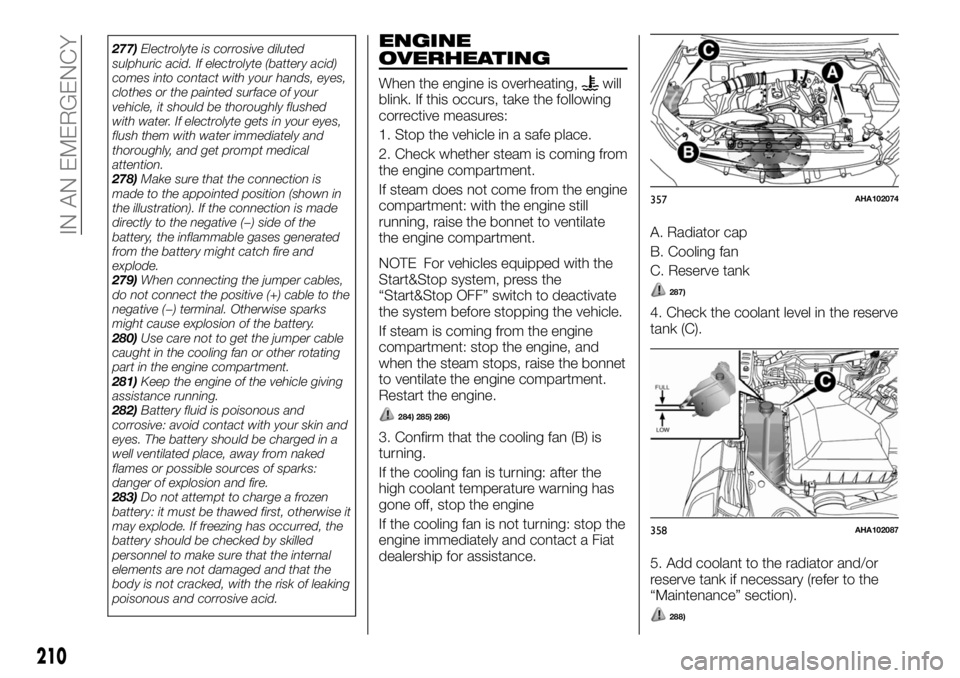
277)Electrolyte is corrosive diluted
sulphuric acid. If electrolyte (battery acid)
comes into contact with your hands, eyes,
clothes or the painted surface of your
vehicle, it should be thoroughly flushed
with water. If electrolyte gets in your eyes,
flush them with water immediately and
thoroughly, and get prompt medical
attention.
278)Make sure that the connection is
made to the appointed position (shown in
the illustration). If the connection is made
directly to the negative (−) side of the
battery, the inflammable gases generated
from the battery might catch fire and
explode.
279)When connecting the jumper cables,
do not connect the positive (+) cable to the
negative (−) terminal. Otherwise sparks
might cause explosion of the battery.
280)Use care not to get the jumper cable
caught in the cooling fan or other rotating
part in the engine compartment.
281)Keep the engine of the vehicle giving
assistance running.
282)Battery fluid is poisonous and
corrosive: avoid contact with your skin and
eyes. The battery should be charged in a
well ventilated place, away from naked
flames or possible sources of sparks:
danger of explosion and fire.
283)Do not attempt to charge a frozen
battery: it must be thawed first, otherwise it
may explode. If freezing has occurred, the
battery should be checked by skilled
personnel to make sure that the internal
elements are not damaged and that the
body is not cracked, with the risk of leaking
poisonous and corrosive acid.ENGINE
OVERHEATING
When the engine is overheating,will
blink. If this occurs, take the following
corrective measures:
1. Stop the vehicle in a safe place.
2. Check whether steam is coming from
the engine compartment.
If steam does not come from the engine
compartment: with the engine still
running, raise the bonnet to ventilate
the engine compartment.
NOTE For vehicles equipped with the
Start&Stop system, press the
“Start&Stop OFF” switch to deactivate
the system before stopping the vehicle.
If steam is coming from the engine
compartment: stop the engine, and
when the steam stops, raise the bonnet
to ventilate the engine compartment.
Restart the engine.
284) 285) 286)
3. Confirm that the cooling fan (B) is
turning.
If the cooling fan is turning: after the
high coolant temperature warning has
gone off, stop the engine
If the cooling fan is not turning: stop the
engine immediately and contact a Fiat
dealership for assistance.A. Radiator cap
B. Cooling fan
C. Reserve tank
287)
4. Check the coolant level in the reserve
tank (C).
5. Add coolant to the radiator and/or
reserve tank if necessary (refer to the
“Maintenance” section).
288)
357AHA102074
358AHA102087
210
IN AN EMERGENCY
Page 213 of 312
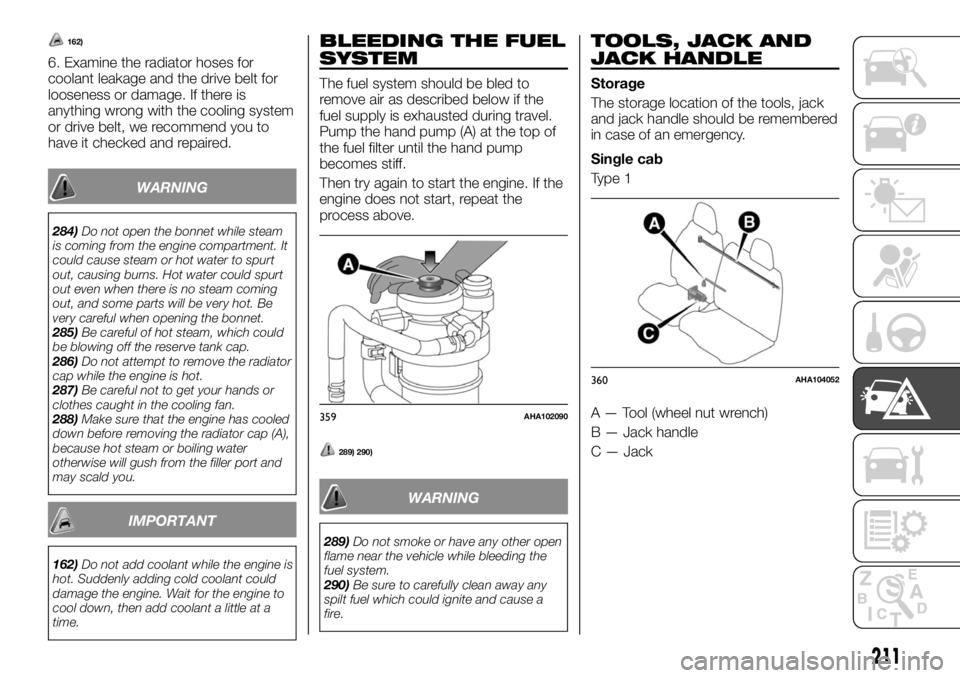
162)
6. Examine the radiator hoses for
coolant leakage and the drive belt for
looseness or damage. If there is
anything wrong with the cooling system
or drive belt, we recommend you to
have it checked and repaired.
WARNING
284)Do not open the bonnet while steam
is coming from the engine compartment. It
could cause steam or hot water to spurt
out, causing burns. Hot water could spurt
out even when there is no steam coming
out, and some parts will be very hot. Be
very careful when opening the bonnet.
285)Be careful of hot steam, which could
be blowing off the reserve tank cap.
286)Do not attempt to remove the radiator
cap while the engine is hot.
287)Be careful not to get your hands or
clothes caught in the cooling fan.
288)Make sure that the engine has cooled
down before removing the radiator cap (A),
because hot steam or boiling water
otherwise will gush from the filler port and
may scald you.
IMPORTANT
162)Do not add coolant while the engine is
hot. Suddenly adding cold coolant could
damage the engine. Wait for the engine to
cool down, then add coolant a little at a
time.
BLEEDING THE FUEL
SYSTEM
The fuel system should be bled to
remove air as described below if the
fuel supply is exhausted during travel.
Pump the hand pump (A) at the top of
the fuel filter until the hand pump
becomes stiff.
Then try again to start the engine. If the
engine does not start, repeat the
process above.
289) 290)
WARNING
289)Do not smoke or have any other open
flame near the vehicle while bleeding the
fuel system.
290)Be sure to carefully clean away any
spilt fuel which could ignite and cause a
fire.
TOOLS, JACK AND
JACK HANDLE
Storage
The storage location of the tools, jack
and jack handle should be remembered
in case of an emergency.
Single cab
Type 1
A — Tool (wheel nut wrench)
B — Jack handle
C — Jack
359AHA102090
360AHA104052
211
Page 248 of 312

Thousand of miles12,5 25 37,5 50 62,5 75 87,5 100 112 125
Thousands of kilometers or20 40 60 80 100 120 140 160 180 200
Years12345678910
Perform the "Small Injection Quantity
Learning” procedure●●●●●●●●●●
Lubricate the appropriate points of the
transmission shaft●●●●●●●●●●
Visually inspect condition of: underbody
protection, pipes and hoses (exhaust, fuel
system), rubber elements (boots, sleeves,
bushes, etc.)
●●●●●●●●●●
Visually inspect the integrity of the steering
components and their fixings (including
gaskets and covers)
●●●●●●●●●●
Visually inspect the condition of the
turbocompressor flexible air intake
couplings and oil conduits (where present)
●●●●●
Check windscreen/rear window wiper blade
position/wear●●●●●
Check operation of the windscreen
wiper/washer system and adjust jets, if
necessary
●●●●●
Check cleanliness of bonnet and luggage
compartment locks, cleanliness and
lubrication of linkage
●●●●●
246
SERVICING AND MAINTENANCE
Page 252 of 312
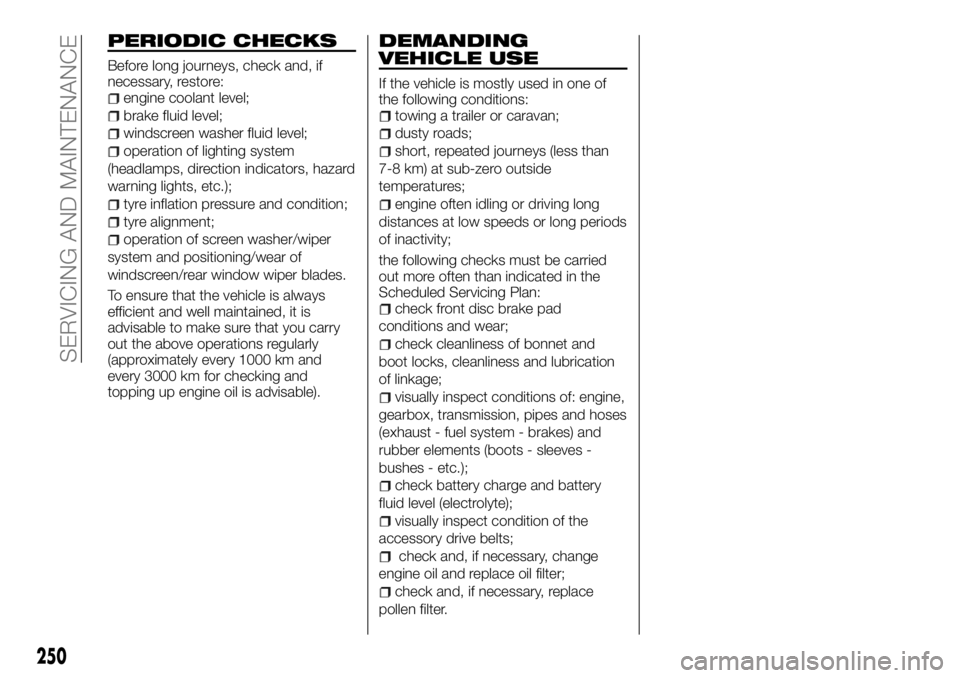
PERIODIC CHECKS
Before long journeys, check and, if
necessary, restore:
engine coolant level;
brake fluid level;
windscreen washer fluid level;
operation of lighting system
(headlamps, direction indicators, hazard
warning lights, etc.);
tyre inflation pressure and condition;
tyre alignment;
operation of screen washer/wiper
system and positioning/wear of
windscreen/rear window wiper blades.
To ensure that the vehicle is always
efficient and well maintained, it is
advisable to make sure that you carry
out the above operations regularly
(approximately every 1000 km and
every 3000 km for checking and
topping up engine oil is advisable).
DEMANDING
VEHICLE USE
If the vehicle is mostly used in one of
the following conditions:
towing a trailer or caravan;
dusty roads;
short, repeated journeys (less than
7-8 km) at sub-zero outside
temperatures;
engine often idling or driving long
distances at low speeds or long periods
of inactivity;
the following checks must be carried
out more often than indicated in the
Scheduled Servicing Plan:
check front disc brake pad
conditions and wear;
check cleanliness of bonnet and
boot locks, cleanliness and lubrication
of linkage;
visually inspect conditions of: engine,
gearbox, transmission, pipes and hoses
(exhaust - fuel system - brakes) and
rubber elements (boots - sleeves -
bushes - etc.);
check battery charge and battery
fluid level (electrolyte);
visually inspect condition of the
accessory drive belts;
check and, if necessary, change
engine oil and replace oil filter;
check and, if necessary, replace
pollen filter.
250
SERVICING AND MAINTENANCE
Page 265 of 312
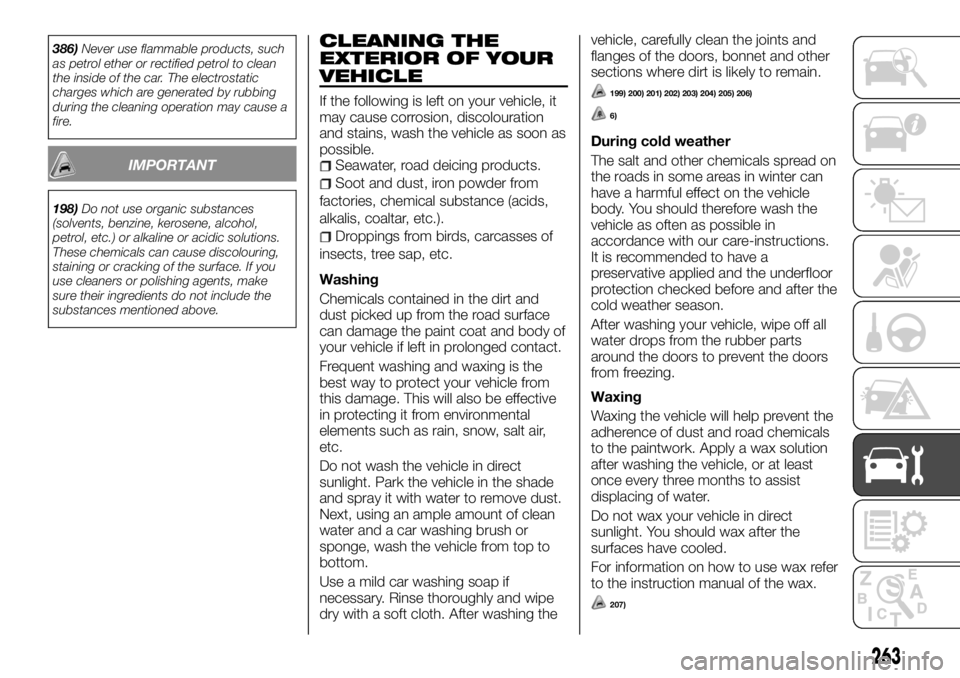
386)Never use flammable products, such
as petrol ether or rectified petrol to clean
the inside of the car. The electrostatic
charges which are generated by rubbing
during the cleaning operation may cause a
fire.
IMPORTANT
198)Do not use organic substances
(solvents, benzine, kerosene, alcohol,
petrol, etc.) or alkaline or acidic solutions.
These chemicals can cause discolouring,
staining or cracking of the surface. If you
use cleaners or polishing agents, make
sure their ingredients do not include the
substances mentioned above.
CLEANING THE
EXTERIOR OF YOUR
VEHICLE
If the following is left on your vehicle, it
may cause corrosion, discolouration
and stains, wash the vehicle as soon as
possible.
Seawater, road deicing products.
Soot and dust, iron powder from
factories, chemical substance (acids,
alkalis, coaltar, etc.).
Droppings from birds, carcasses of
insects, tree sap, etc.
Washing
Chemicals contained in the dirt and
dust picked up from the road surface
can damage the paint coat and body of
your vehicle if left in prolonged contact.
Frequent washing and waxing is the
best way to protect your vehicle from
this damage. This will also be effective
in protecting it from environmental
elements such as rain, snow, salt air,
etc.
Do not wash the vehicle in direct
sunlight. Park the vehicle in the shade
and spray it with water to remove dust.
Next, using an ample amount of clean
water and a car washing brush or
sponge, wash the vehicle from top to
bottom.
Use a mild car washing soap if
necessary. Rinse thoroughly and wipe
dry with a soft cloth. After washing thevehicle, carefully clean the joints and
flanges of the doors, bonnet and other
sections where dirt is likely to remain.
199) 200) 201) 202) 203) 204) 205) 206)
6)
During cold weather
The salt and other chemicals spread on
the roads in some areas in winter can
have a harmful effect on the vehicle
body. You should therefore wash the
vehicle as often as possible in
accordance with our care-instructions.
It is recommended to have a
preservative applied and the underfloor
protection checked before and after the
cold weather season.
After washing your vehicle, wipe off all
water drops from the rubber parts
around the doors to prevent the doors
from freezing.
Waxing
Waxing the vehicle will help prevent the
adherence of dust and road chemicals
to the paintwork. Apply a wax solution
after washing the vehicle, or at least
once every three months to assist
displacing of water.
Do not wax your vehicle in direct
sunlight. You should wax after the
surfaces have cooled.
For information on how to use wax refer
to the instruction manual of the wax.
207)
263
Page 267 of 312
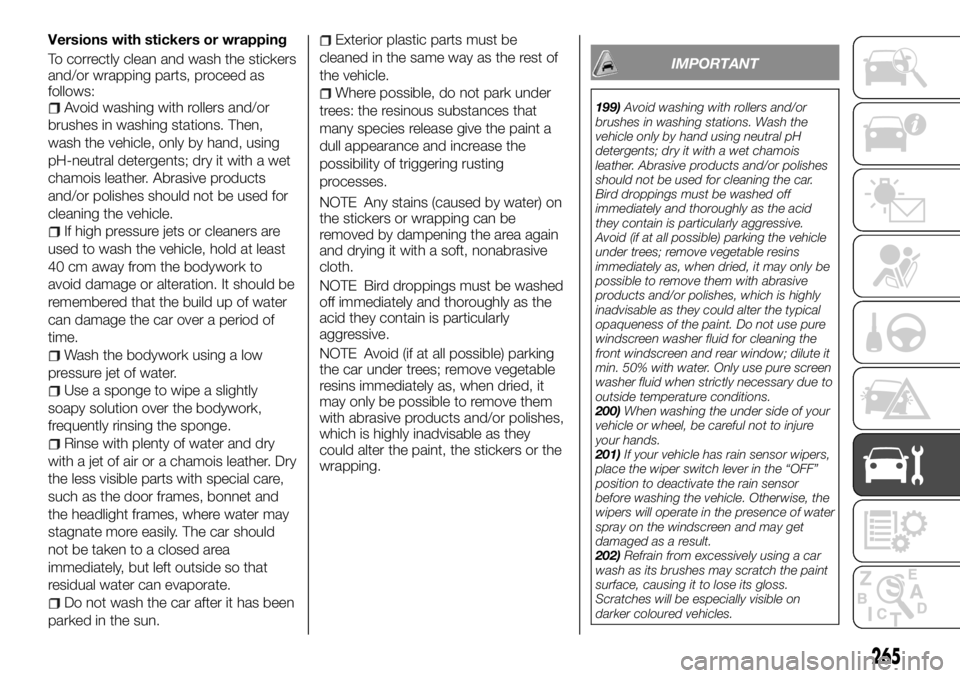
Versions with stickers or wrapping
To correctly clean and wash the stickers
and/or wrapping parts, proceed as
follows:
Avoid washing with rollers and/or
brushes in washing stations. Then,
wash the vehicle, only by hand, using
pH-neutral detergents; dry it with a wet
chamois leather. Abrasive products
and/or polishes should not be used for
cleaning the vehicle.
If high pressure jets or cleaners are
used to wash the vehicle, hold at least
40 cm away from the bodywork to
avoid damage or alteration. It should be
remembered that the build up of water
can damage the car over a period of
time.
Wash the bodywork using a low
pressure jet of water.
Use a sponge to wipe a slightly
soapy solution over the bodywork,
frequently rinsing the sponge.
Rinse with plenty of water and dry
with a jet of air or a chamois leather. Dry
the less visible parts with special care,
such as the door frames, bonnet and
the headlight frames, where water may
stagnate more easily. The car should
not be taken to a closed area
immediately, but left outside so that
residual water can evaporate.
Do not wash the car after it has been
parked in the sun.
Exterior plastic parts must be
cleaned in the same way as the rest of
the vehicle.
Where possible, do not park under
trees: the resinous substances that
many species release give the paint a
dull appearance and increase the
possibility of triggering rusting
processes.
NOTE Any stains (caused by water) on
the stickers or wrapping can be
removed by dampening the area again
and drying it with a soft, nonabrasive
cloth.
NOTE Bird droppings must be washed
off immediately and thoroughly as the
acid they contain is particularly
aggressive.
NOTE Avoid (if at all possible) parking
the car under trees; remove vegetable
resins immediately as, when dried, it
may only be possible to remove them
with abrasive products and/or polishes,
which is highly inadvisable as they
could alter the paint, the stickers or the
wrapping.
IMPORTANT
199)Avoid washing with rollers and/or
brushes in washing stations. Wash the
vehicle only by hand using neutral pH
detergents; dry it with a wet chamois
leather. Abrasive products and/or polishes
should not be used for cleaning the car.
Bird droppings must be washed off
immediately and thoroughly as the acid
they contain is particularly aggressive.
Avoid (if at all possible) parking the vehicle
under trees; remove vegetable resins
immediately as, when dried, it may only be
possible to remove them with abrasive
products and/or polishes, which is highly
inadvisable as they could alter the typical
opaqueness of the paint. Do not use pure
windscreen washer fluid for cleaning the
front windscreen and rear window; dilute it
min. 50% with water. Only use pure screen
washer fluid when strictly necessary due to
outside temperature conditions.
200)When washing the under side of your
vehicle or wheel, be careful not to injure
your hands.
201)If your vehicle has rain sensor wipers,
place the wiper switch lever in the “OFF”
position to deactivate the rain sensor
before washing the vehicle. Otherwise, the
wipers will operate in the presence of water
spray on the windscreen and may get
damaged as a result.
202)Refrain from excessively using a car
wash as its brushes may scratch the paint
surface, causing it to lose its gloss.
Scratches will be especially visible on
darker coloured vehicles.
265